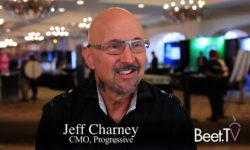ORLANDO—Marketers need to find the nexus of performance marketing—“a bunch of clicks and data and sets”—and the big, thematic and typically slow-moving ideas that have long characterized brand marketing, according to the CMO of Clorox.
“I’m going to suggest that we have to figure out how to pull them both together around one consumer in order to really drive the growth we want. But it’s not an either or. But it’s an and,” says Eric Reynolds.
Reynolds was referencing his talk at the recent Association of National Advertisers’ Masters of Marketing conference, where he discussed “the tension between performance marketing, or growth marketing, and brand marketing.” His presentation was titled Path To Growth: A Modern Marketing Dilemma.
Among other insights Reynolds shares in this interview with Beet.TV, he talks about the slow and steady decline of linear television as a means of reaching consumers and how Clorox has been moving out of both print and TV in favor of digital—video in particular.
Why performance marketing does very well is because it’s data-rich, agile and nimble. “It’s actually way much more consumer-focused than classic brand marketing, which is the way I grew up. It’s because they’re very intimate with the consumer and they change fast,” Reynolds says.
The problem with performance marketing is “you run out of steam fast…because you fundamentally don’t know the person you’re trying to build a relationship with your brand. It’s just a bunch of clicks and data and sets. And that will get you so far.”
On the other end of the spectrum, brand marketing provides a strong understanding of consumers at a life and a category level. “It creates enduring ideas that keep people coming back. And you need both is the point. If we’re all just about activation through data, then we really don’t have a brand,” Reynolds adds.
“But if we’re only talking big, thematic, large-scale ideas that are slow, well we’re not rising to the challenge that consumers expect us to do, which is to have that real time, that intimate, be-useful relationship so you really need to do both.”
Asked for a breakdown of Clorox’s media choices, Reynolds says they’re constantly changing but tied less to a “big, strategic choice” and much more to “following where consumers are open to receiving messages and information from us. And what that means broad-scale is for a us a consistent decline in linear TV, year on year on year, and a rise in more assignable media like digital display, video, social. And we see these trends continuing.”
As the company’s analytics have evolved, providing ever more insight into how media is performing for sales, “well over” 60% of Clorox’s media is now digital.
“Now video, though, is the place where it’s all heading towards, because for our categories and our brands, it’s the place where we tell the richest stories, the kind of stories whether they’re product stories or category stories or brand stories, that seems to be the place where consumers want to engage with us.”
This series “Growing Brands and Driving Results,” was produced at the ANA Masters in Marketing ’18 conference in Orlando. The series is sponsored by the FreeWheel Council for Premium Video. Please find additional coverage here.






































